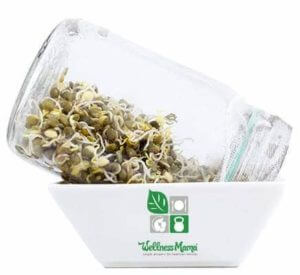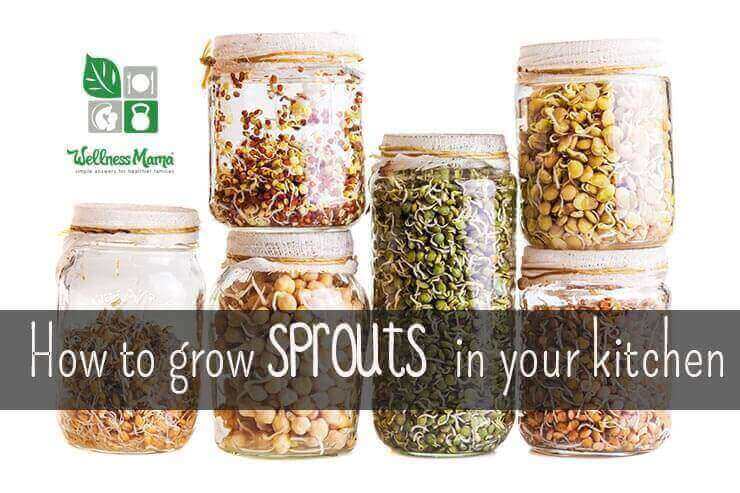“A total hippie food”… that was what I thought as I looked down at the turkey, sprouts, and avocado sandwich on flax bread that my friend had insisted I “had to try.”
This was well before my transition to real food and I wasn’t enthralled with the rather dry sandwich, but I really liked the texture of the sprouts.
These days, if sprouts are hippie food, I must be a hippie because I have some growing on my counter right now.
Turns out, sprouts have a lot of health benefits and are an inexpensive and easy-to-grow local superfood.
Why Grow Sprouts at Home?
Sprouts are soaked and germinated seeds, nuts or grains that are full of beneficial enzymes, vitamins and amino acids. They are also incredibly easy to grow at home on a kitchen counter with plain water and minimal equipment.
I prefer to sprout any beans or grains that I consume to make the nutrients more bioavailable and to reduce lectins and phytic acid. I also like sprouting certain seeds and nuts for adding to salads and stir frys.
Sprouts are incredibly nutritious and inexpensive, and take only a few days to grow. Sprouting increases the nutrient content of seeds and legumes and makes them easier to digest. If you’ve never tried to grow sprouts at home, you are missing out on an easy way to have fresh food year round.
The most common seeds used to grow sprouts are:
- Alfalfa
- Broccoli Seeds
- Red Clover Seeds
- Lentils
- Mung Beans
- Pumpkin Seeds
- Sunflower Seeds
- Chia Seeds
Supplies to Grow Sprouts
There is equipment specifically designed for sprouting, like sprouting trays, which make sprouting easier and allow for more growth at once, but all that is really needed are:
- A wide-mouth quart size or half gallon size mason jar
- A Sprouting lid or a piece of cheesecloth and a rubber band
- A bowl or box to help the jar stand upside-down at an angle
- Organic Sprouting seeds (I buy mine in bulk here) – Make sure they are specifically labeled “sprouting seeds” and “organic”
How to Grow Sprouts

- Wash hands well and make sure that all equipment is clean and sterile.
- Pour one type of seed into the jar. Use about 1 teaspoon of small seeds like alfalfa or broccoli or 1/4 cup of beans and lentils (for a quart size jar).
- Cover with 1 cup of filtered water and put lid or cheesecloth over the jar.
- Allow to soak for up to 12 hours. It is often easiest to do this at night and soak overnight.
- In the morning, strain off the water. This is easily done with a sprouting lid. If you are using a cheesecloth, strain through a fine strainer and return to jar.
- Rinse well with filtered water and drain again.
- Place upside down at a slight angle so that excess water can drain off and air can get in. I find a dish rack or medium size bowl is perfect for this.
- Re-rinse the sprouts several times a day with filtered water, returning to the tilted position each time.
- You should see sprouting in a day or two and most sprouts are ready to harvest in 3-7 days.
- When done sprouting, rinse thoroughly in cool, filtered water and store in a covered container in the fridge for up to a week.
There are some important notes about growing sprouts. Please read this article for cautions and specific instructions. Some seeds (like walnuts and pecans) do not sprout and some beans (like Kidney beans) are dangerous and should never be eaten sprouted. Also, special care should be taken to avoid bacteria growth in sprouts.
Ever eaten sprouts or made your own? Let me know below!



Leave a Reply